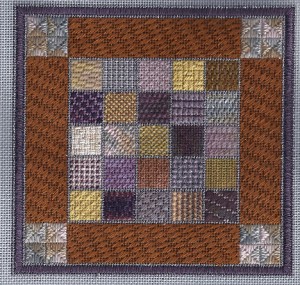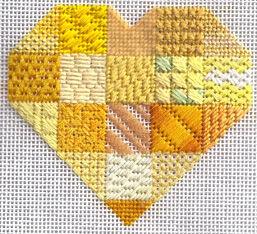
Books are tools, not just static storage for information. Those great needlepoint stitches aren’t worth much if you can’t use them.
All too often you can’t because the books aren’t useful for you.
Today we’ll talk about what defines a tiny stitch and I’ll give you some tips on hacking your books to make them more useful for finding small needlepoint stitches.
What’s a Small Needlepoint Stitch?
For a stitch to fit into a space, there needs to be three repeats of the stitch unit. That is enough to allow your eye to see a pattern. By seeing a pattern your brain “fills in” the missing stitches so that it looks as if the pattern continues behind other objects. Without this level of repetition, your brain doesn’t see pattern, it sees visual noise.
Looking at needlepoint canvases, we tend to think of tiny areas as those that are 1 or 2 threads square. If your space is bigger than that you’ve got lots more choices. It’s these small areas that cause problems.
I call a small stitch any stitch that is 3-4 threads square or smaller. While others may disagree, I find this breakdown allows me easily to identify needlepoint stitches for small spaces.
Hack those Books!
I’ve come up with four wonderful ways to make your stitch dictionary books more useful. Try some or all of these.
- Slice off the binding and comb-bind your books. I got this tip at a local needlepoint shop and it is so wonderful. For books that don’t have comb-binding, such as The Needlepoint Book, go to a local copy center and have them rebind the book this way. You can only do this with paperbacks, not with hardbound books.
It makes the book flat when you open it and much more useful.
And, best of all, it only costs a couple of bucks.
- Highlight the small stitches. Get two colors of highlighters. Mark the stitches that are one or two threads in one color and three or four threads in the other. Don’t worry about stitches such as Darcy’s Check, pictured above, that have more than one unit to a repeat. This tool is supposed to give you a broad range of possibilities. If the book has an index, do the same highlighting job there.
When you are paging through the book the highlighted stitches will stand out, making it easier to find those small stitches.
- Make a spreadsheet of small stitches.If you have lots of books, this is really helpful. Set up a spreadsheet with these coloumns:
- Stitch name
- size
- family
- book
- page #
- ebook version?
Don’t try to do this all at once, do a bit at a time. This summarizes what you’ve got and allows you to go to the correct stitch quickly.
- Buy electronic versions of your books. While paging through the paper book is wonderful for sparking ideas, the easy portability of electronic versions allows you to carry hundreds of stitches in something small.
This is even more wonderful if you travel. Then your stitching life is much more portable.
If you aren’t spreadsheet-handicapped (I am), you could even put those small stitch spreadsheets on the same device, making them even better.

Small Stitch Sampler Resources
I have four small stitch samplers available, now in one combined book (buy it below for $39). They each include dozens of stitches for small spaces. The projects are simple, easy enough for beginners, and will increase your arsenal of stitches greatly.
The projects can be stitched on any mesh in any thread or color you like, so they really become a personal project.
Get your copy of the small stitches at this special pre-publication price by using the button below. Individually the four samplers are $15 each. The book will be published later this month.
You can also get more small stitch goodness with the new and expanded hearts sampler book in one volume. There are over 100 small stitches, many new to these projects, put in one great volume. Buy it at the pre-purchase price of $15 using the button below.
About Janet M Perry
Janet Perry is the Internet's leading authority on needlepoint. She designs, teaches and writes, getting raves from her fans for her innovative techniques, extensive knowledge and generous teaching style. A leading writer of stitch guides, she blogs here and lives on an island in the northeast corner of the SF Bay with her family


Leave a Reply